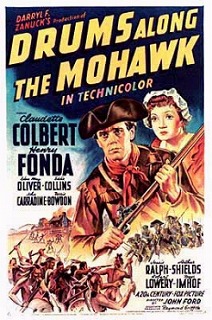 I'm sure TCM has done it before, but they're spending prime time tonight showing a bunch of films directed by John Ford. First up, at 8:00 PM, is a film that's lovely to look at, although I don't know quite how realistic it is: Drums Along the Mohawk.
I'm sure TCM has done it before, but they're spending prime time tonight showing a bunch of films directed by John Ford. First up, at 8:00 PM, is a film that's lovely to look at, although I don't know quite how realistic it is: Drums Along the Mohawk.
The film kicks off in Albany, New York, in the early 1770s. At the time, Albany was a relative backwater, with the commerce all flowing along the Hudson River to New York City. Albany was more the gateway to the underdeveloped areas of the Adirondacks, and what is now western New York, with the Mohawk River being a vital avenue to the western frontier. Gil Martin (Henry Fonda) is one of those frontiersman trying to create a new country out in the "west", and he's in Albany looking for a wife, whom he finds in Lana (Claudette Colbert).
What she doesn't know is just how difficult the life of a wife on the frontier is. This frontier isn't quite as underdeveloped as, say, the frontier Robert Mitchum and William Holden inhabited in Rachel and the Stranger, but it's not far off. As with that later movie, the Indians here are raiding the white settlers; the Indians had fought for the British in the French and Indian Wars 15 years earlier, and were told they'd be allowed to live in relative peace, which these settlers are disturbing. Anyhow, those attacks are about to get worse, because as you would have noticed by the date, New York was about to get caught up in the Revolutionary War along with the rest of the colonies.
For Gil and Lana, this means seeing their farm burned to the ground, and being forced to move in with the strong-minded widow McKlennar (Edna May Oliver). For Gil, it also means making the difficult decision to join with the other settlers and fight against the British, or at least their proxy in the Indians, who are commanded by the British officer Caldwell (John Carradine). History, of course, tells us that the colonists are going to defeat the British. Specifically for western New York, this means the Battle of Oriskany. In the movie, all the settlers gather at the fort for the coming Indian raid, which in typical John Ford style is quite well executed.
As for the movie as a whole, it's entertaining and beautiful. John Ford was using Technicolor for the first time, and as I've said elsewhere, I think the Technicolor of the time worked quite well for historical movies like Drums Along the Mohawk, and it's so much nicer to see these color images than, say, the black-and-white of Hudson's Bay, made at Fox a few years later. Henry Fonda is good, solid as always. Claudette Colbert's left side is certainly pretty, but looks much too modern for the 1770s. Somehow I get the feeling that the real life Claudeet Colbert would have been even more unable to cope with farm life than her character here. Edna May Oliver steals a lot of her scenes with wonderful lines and an attitude that makes you wonder why she never got cast as Glenda Farrell's mother. John Carradine, like Fonda, also fits in quite well in the Revolutionary era and is as good as always at playing a darker character.
I don't know how much of Drums Along the Mohawk represents accurate history, but it's still a movie that's well worth watching.
Noirsville Noir Images of the Week
1 hour ago

No comments:
Post a Comment